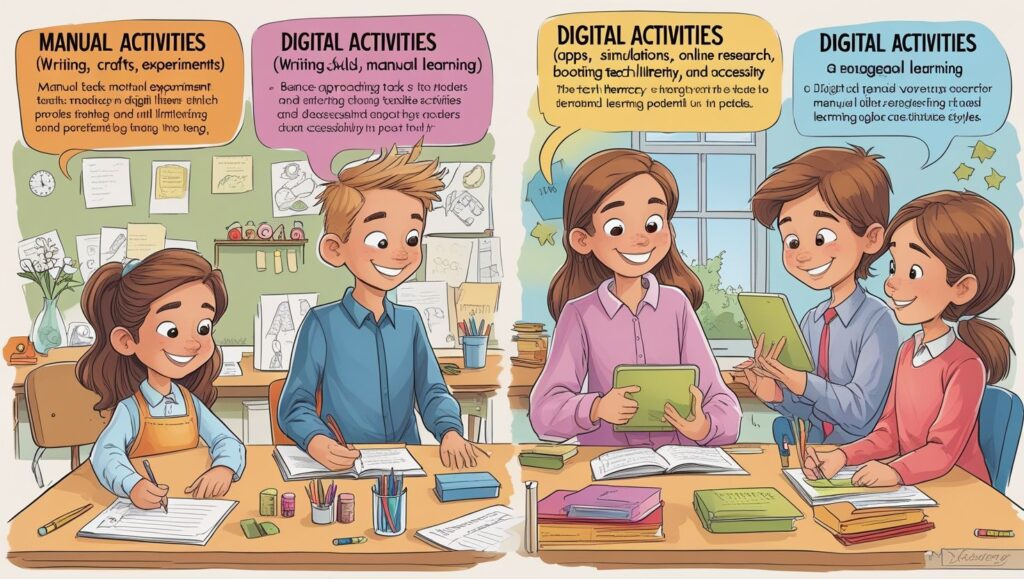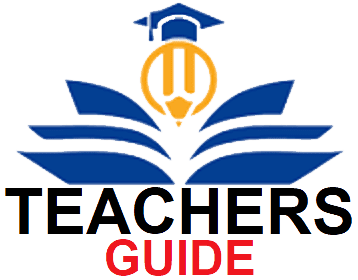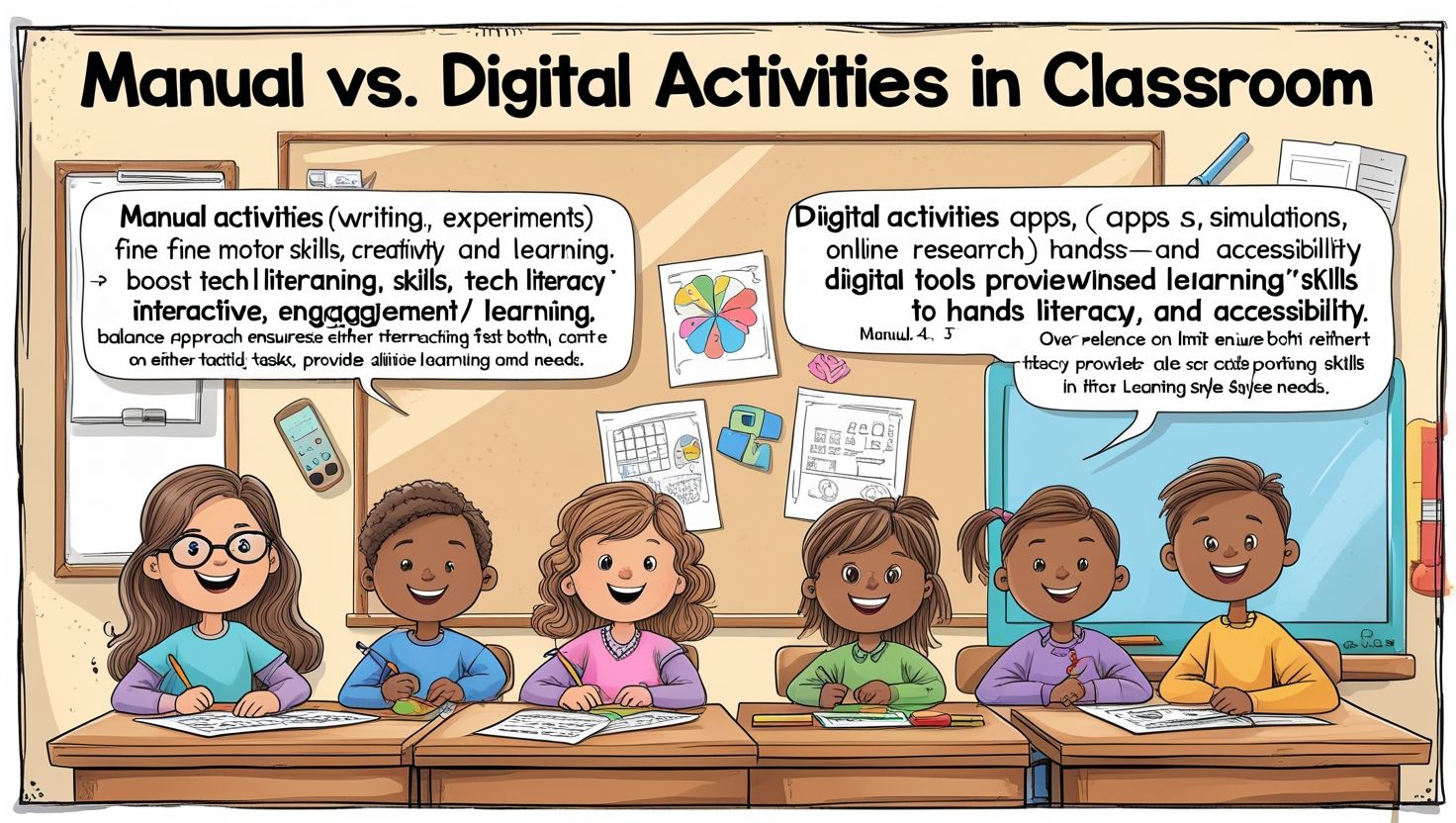1. Introduction:
Manual vs Digital Activities in the Classroom, The modern classroom is undergoing a significant transformation as digital tools increasingly supplement or even replace traditional, manual teaching methods. This shift has led to debates about the advantages and drawbacks of manual versus digital activities in fostering student engagement, understanding, and critical thinking. While manual activities—such as handwriting, drawing, and hands-on experiments—have been long cherished for their sensory involvement and tactile reinforcement, digital activities are praised for their speed, interactivity, and access to global resources.
Each method contributes uniquely to students’ learning experiences. In educational settings, the challenge lies not in choosing one over the other but in understanding the roles they play and integrating them wisely. With the rise of EdTech, learning apps, smartboards, and virtual classrooms, the line between manual and digital activities continues to blur. This article critically compares both modes, analyzing their effectiveness, benefits, limitations, and future roles in education. It seeks to assist educators and policymakers in making informed choices for a balanced, enriched classroom environment that supports holistic learning.
2. Understanding Manual Activities in the Classroom
Manual activities in the classroom refer to traditional, hands-on tasks that involve physical interaction with materials. These include writing in notebooks, crafting models, solving problems on the board, conducting science experiments, painting, or participating in role-playing and storytelling. Such activities promote tactile learning, where students learn by touching, feeling, and doing. They help enhance motor skills, concentration, creativity, and memory retention. For instance, the act of handwriting not only improves fine motor skills but also strengthens cognitive connections related to spelling and language structure.
Manual tasks often allow for personalized and reflective learning, where students take time to process information and express it through physical output. Moreover, group manual tasks foster cooperation, communication, and peer bonding, which are critical in early education. Though sometimes considered slow or less engaging in the tech-savvy world, these methods continue to be vital for student development. They create a grounded learning environment, especially effective in resource-constrained schools where digital access may be limited or unreliable.

3. The Rise of Digital Activities in Modern Classrooms
Digital activities encompass the use of technology-driven tools and platforms to facilitate learning. These include interactive whiteboards, tablets, e-books, educational apps, virtual labs, online quizzes, and multimedia presentations. Digital methods have grown in popularity due to their ability to make learning more interactive, visual, and customizable. They offer immediate feedback, track student progress in real time, and provide access to vast digital resources from across the world.
For instance, an online math tool can help a student visualize complex problems through simulations, something manual methods may not easily achieve. Especially during the COVID-19 pandemic, digital activities became a necessity, showcasing their flexibility in both physical and remote classrooms. They are inclusive in that they often cater to varied learning styles—visual, auditory, and kinesthetic—through a single platform. However, they also demand technological infrastructure, stable internet connectivity, and digital literacy from both students and teachers. Digital learning has revolutionized education, but its success largely depends on how effectively it is integrated into the curriculum alongside traditional teaching.
4. Comparing Engagement: Manual vs Digital Learning
Student engagement is critical for effective learning, and both manual and digital activities influence it differently. Manual activities engage students physically and emotionally through real-world experiences—cutting, drawing, acting, or handwriting. These activities develop patience, persistence, and a deeper connection with the learning process. On the other hand, digital activities use animations, gamification, and instant results to stimulate quick attention and response. For example, an online quiz with points and rewards can excite learners, especially younger ones. However, such stimulation may sometimes lead to superficial engagement without deep understanding.
Manual activities often allow students to reflect, question, and absorb content more organically, albeit slowly. Meanwhile, digital activities encourage fast-paced learning but may compromise retention if overused. Balancing both methods can maintain high engagement while preserving the depth of understanding. A classroom that blends coloring a diagram by hand with exploring the same concept through a digital simulation achieves a dual impact: tactile and visual engagement. Thus, hybrid models are proving most effective in sustaining diverse learner interests.
5. Skill Development Through Manual and Digital Tasks
Both manual and digital activities contribute significantly to skill development but in different areas. Manual tasks help students cultivate fine motor skills, hand-eye coordination, patience, and practical problem-solving. For example, crafting a clay model enhances spatial awareness and creativity. These tasks also build interpersonal skills through group-based assignments and promote responsibility by requiring careful use of physical materials. In contrast, digital activities foster technological proficiency, digital literacy, and information management skills. Students learn to use software, research online, create presentations, and navigate virtual platforms.
These skills are vital for 21st-century careers. Furthermore, digital tools promote quick adaptation to evolving technologies, coding skills, and algorithmic thinking. However, over-dependence on digital tools may result in reduced physical dexterity or limited social interaction. An ideal curriculum incorporates both methods—for example, combining handwriting practice with digital typing drills, or pairing field notes with an online research report. This dual approach ensures students gain a well-rounded set of competencies required for modern educational and professional environments.

6. Accessibility and Inclusivity in Both Modalities
Accessibility and inclusivity are crucial in education, and both manual and digital activities offer distinct benefits. Manual activities can be more inclusive for students in under-resourced schools, as they require minimal technology. These tasks also allow teachers to offer one-on-one support without needing technical skills. However, digital activities have the potential to be even more inclusive when infrastructure allows.
Assistive technologies—such as screen readers, speech-to-text tools, and interactive audio books—can significantly enhance learning for students with disabilities. Online platforms can translate content into multiple languages, supporting learners from diverse linguistic backgrounds. Additionally, digital tools can offer personalized learning experiences that adapt to the pace and style of each student. Yet, disparities in internet access, device availability, and digital skills can hinder inclusivity. The key lies in thoughtful implementation—ensuring that digital tools are used to bridge gaps rather than widen them.
7. Cost and Resource Considerations
When analyzing the feasibility of manual versus digital activities, cost is a major factor. Manual activities generally incur low upfront costs—requiring stationery, art supplies, textbooks, and basic lab equipment. These resources are usually reusable and easy to maintain. However, over time, recurring purchases for consumables may add up. In contrast, digital activities often require significant initial investments in hardware like tablets, smartboards, computers, and software subscriptions.
Maintenance, training, and tech support also demand ongoing financial input. Yet, in the long run, digital platforms can reduce printing costs, offer reusable content, and support remote learning, making them cost-effective for larger systems. The digital divide, however, is real—many schools in rural or low-income areas cannot afford such technologies, making manual activities the default mode. A cost-benefit analysis should factor in not only money but also educational outcomes. Hybrid systems—where digital tools are introduced gradually and supplemented by manual methods—may offer the most sustainable and cost-efficient educational model for diverse classroom settings.
8. Impact on Teacher Roles and Methodology
The choice between manual and digital activities significantly influences the teaching process. With manual activities, teachers act as facilitators of hands-on exploration, guiding group discussions, art projects, or science experiments. This approach allows for real-time observation and correction, fostering a strong teacher-student connection. However, it can be time-consuming and demands creativity in designing effective tasks. Digital tools, on the other hand, transform the teacher’s role from a content provider to a digital guide or mentor. Platforms offer automated grading, data analytics, and multimedia lessons, reducing teachers’ administrative load.
Yet, digital integration requires teachers to possess technical skills and adaptability. Some educators may struggle with this transition without adequate training. Digital platforms can also depersonalize learning if used excessively, weakening the student-teacher bond. The best outcomes emerge when teachers effectively blend both modes—using a whiteboard for brainstorming and following it up with a digital presentation. Professional development programs must support teachers in mastering both approaches for comprehensive classroom leadership.

9. Long-Term Learning Outcomes and Retention
Studies show that both manual and digital activities influence learning retention in distinct ways. Manual methods tend to result in deeper cognitive processing. For example, writing notes by hand improves memory, comprehension, and critical thinking. Physical involvement in tasks, such as creating a science model, enables better internalization of concepts. These activities typically involve more time and effort, reinforcing learning through repetition and engagement.
In contrast, digital tools allow for rapid information access and diverse content formats, which can stimulate interest and comprehension, especially for visual learners. However, information may be processed more passively and forgotten quickly without reinforcement. Retention improves when digital activities are paired with active tasks, like taking handwritten notes from an online lecture. Additionally, gamified learning platforms enhance memory through spaced repetition and rewards. Long-term outcomes are most promising in blended classrooms, where manual and digital techniques are used to reinforce each other. Educators must design lessons that combine physical and virtual components for optimal knowledge retention.
10. Conclusion: Toward a Blended Future in Education
The debate between manual and digital activities in classrooms is not about choosing one over the other but about striking the right balance. Manual tasks offer foundational skills—fine motor development, attention, social interaction, and deep processing—essential for young learners and hands-on subjects. Digital activities, on the other hand, bring innovation, inclusivity, and access to vast learning tools that prepare students for the future. An effective educational model should neither abandon traditional methods nor rely entirely on technology.
Instead, it should integrate both to cater to diverse learning needs, contexts, and capabilities. Teachers play a vital role in curating this blend, guided by student feedback, pedagogical goals, and resource availability. Governments and school administrators must invest in teacher training, infrastructure, and policy frameworks that support blended learning environments. By harmonizing manual and digital strategies, classrooms can evolve into dynamic spaces that nurture creativity, critical thinking, and lifelong learning skills for every student.


İstanbul su kaçağı tespiti Kaçağı tespit etmek için geldiler, her şeyi tertemiz bıraktılar. Süper! https://linkedbusiness.onjcameroun.cm/read-blog/1084
lbgh3u
ijp83u
Whats up very nice blog!! Guy .. Beautiful .. Amazing .. I’ll bookmark your web site and take the feeds additionallyKI’m glad to seek out numerous helpful information here within the submit, we’d like work out more strategies in this regard, thank you for sharing. . . . . .
I’d always want to be update on new articles on this site, saved to my bookmarks! .
Merely wanna input that you have a very nice web site, I like the design it really stands out.
Pretty! This was a really wonderful post. Thank you for your provided information.
I do agree with all of the ideas you have presented in your post. They are very convincing and will certainly work. Still, the posts are very short for novices. Could you please extend them a little from next time? Thanks for the post.
Some really interesting information, well written and generally user pleasant.
Hey! Do you know if they make any plugins to help with SEO? I’m trying to get my blog to rank for some targeted keywords but I’m not seeing very good success. If you know of any please share. Many thanks!
This is a very good tips especially to those new to blogosphere, brief and accurate information… Thanks for sharing this one. A must read article.
Nice post. I learn something more challenging on different blogs everyday. It will always be stimulating to read content from other writers and practice a little something from their store. I’d prefer to use some with the content on my blog whether you don’t mind. Natually I’ll give you a link on your web blog. Thanks for sharing.